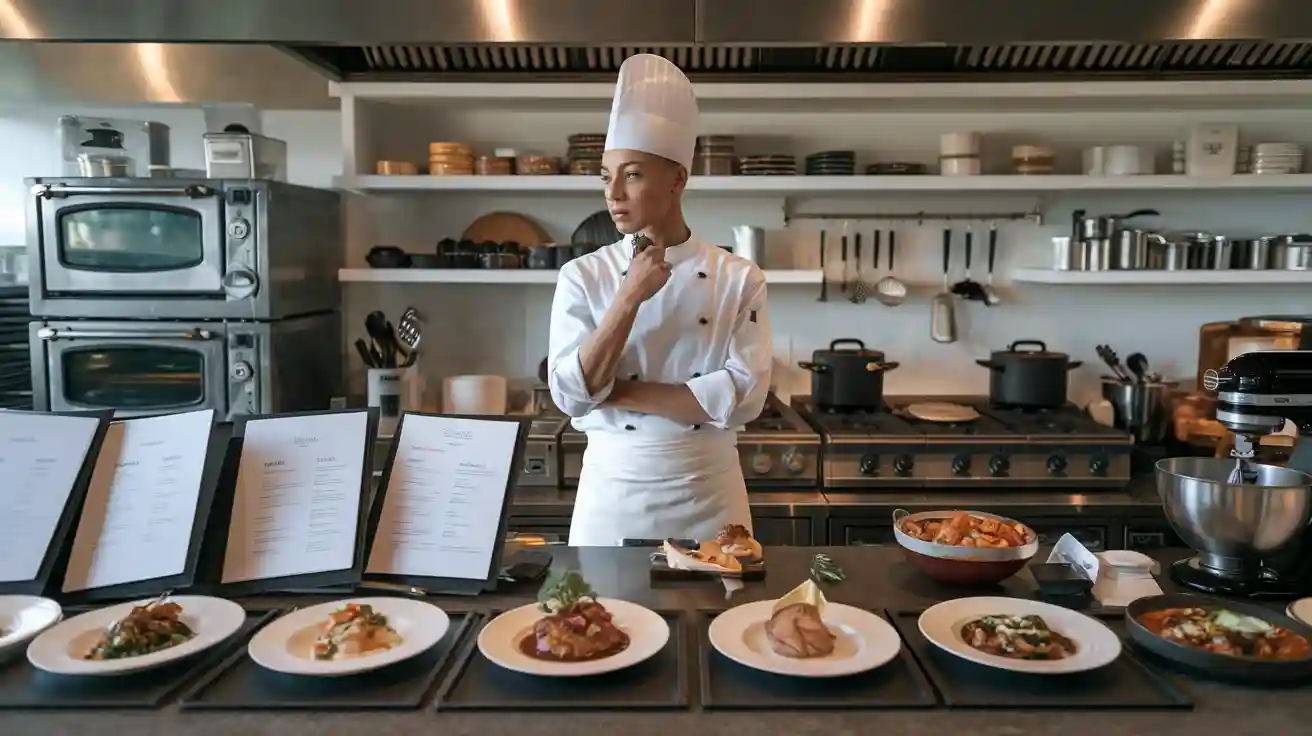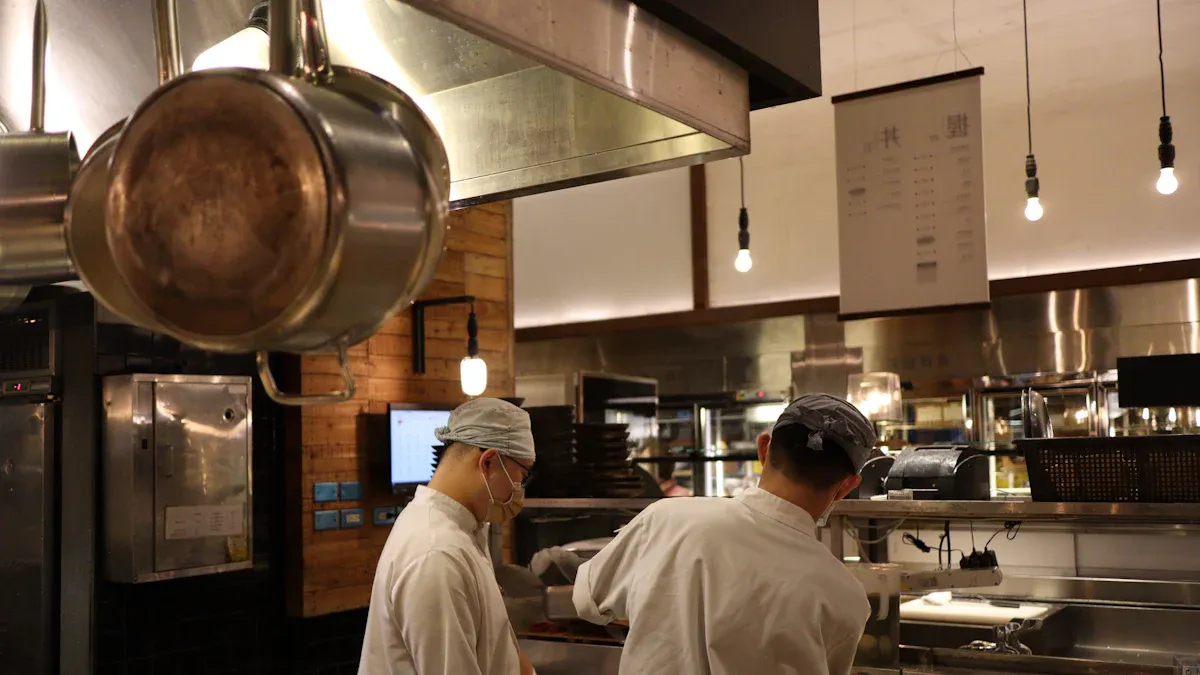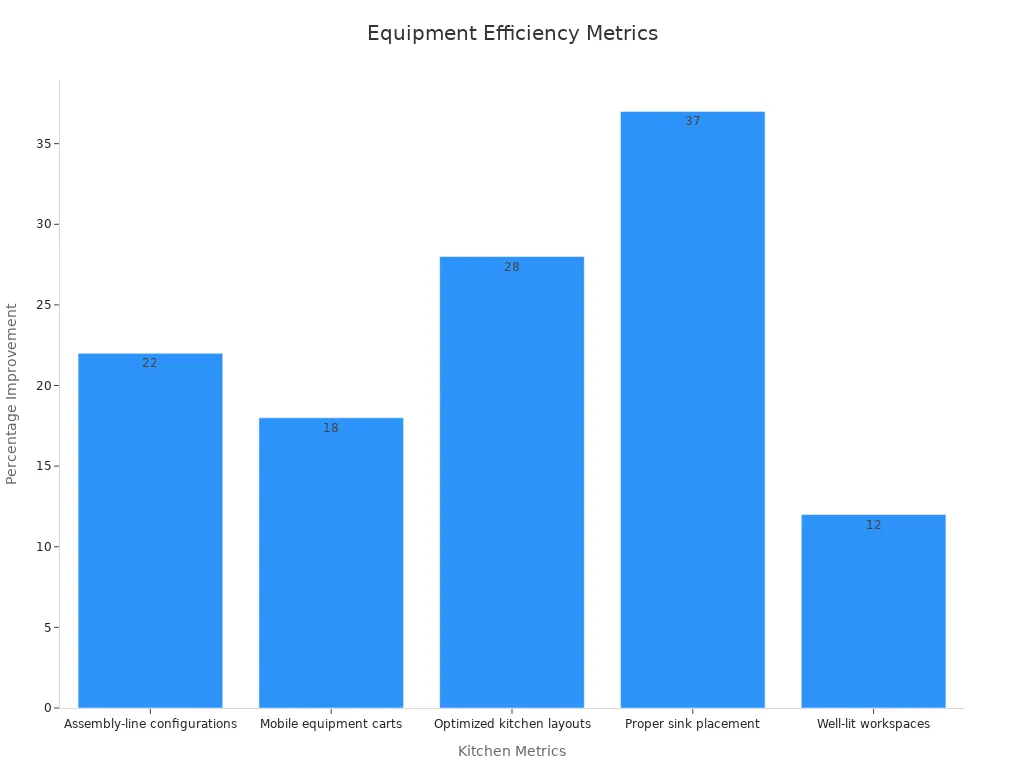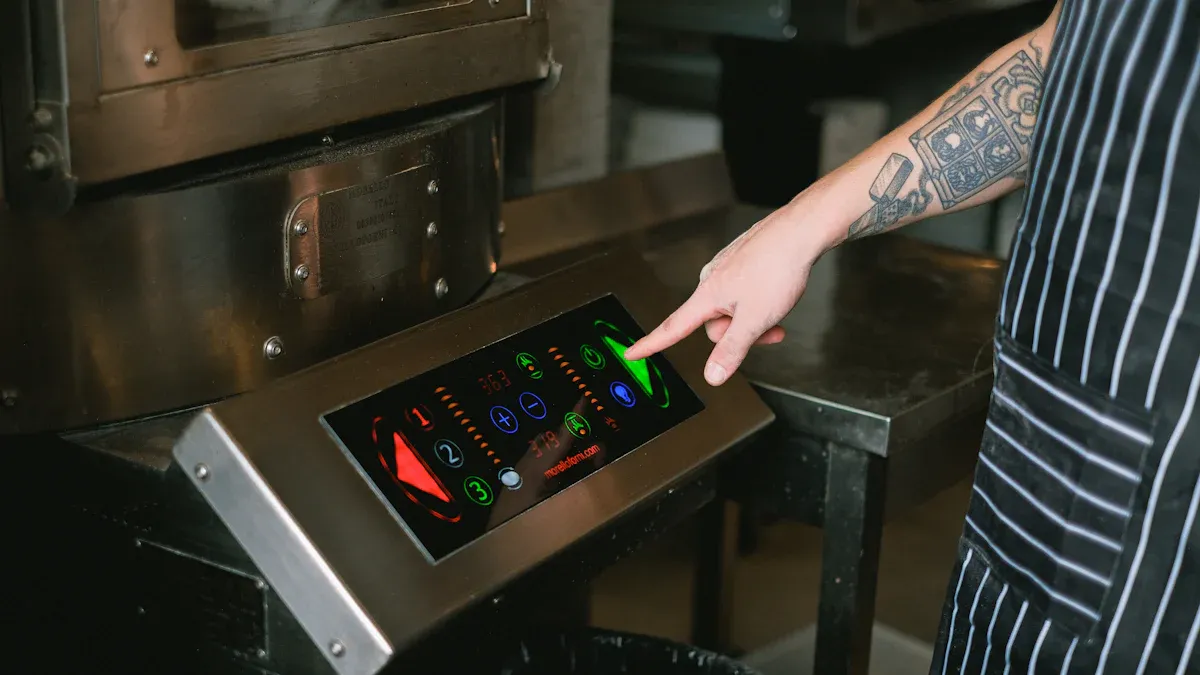
You achieve reliable results in your restaurant by matching restaurant cooking equipment to your menu and kitchen demands. When you analyze your menu, estimate daily volume, and assess kitchen layout, you ensure restaurant kitchen equipment supports productivity. Monitoring throughput, cycle time, and OEE helps you make informed equipment selection and address key factors to consider when purchasing restaurant equipment.
Menu Analysis for Restaurant Cooking Equipment
Identifying Essential Equipment for Core Dishes
You need to start your equipment selection by breaking down your menu. Each core dish requires specific restaurant kitchen equipment to ensure quality and consistency. For example, if your menu features grilled meats, you must include ranges and ovens that can handle high temperatures and frequent use. When you analyze your menu, you identify the essential pieces of restaurant equipment that support your signature offerings.
- Full-service restaurants make up 43.4% of the food service equipment market in 2024. Their diverse menus demand specialized commercial restaurant equipment.
- Quick service restaurants grow rapidly, driven by menu innovation and convenience. This trend increases the need for tailored restaurant kitchen equipment.
- Cloud kitchens and delivery-focused models require equipment that matches their unique menu and operational needs.
- Labor shortages and stricter health regulations push you to choose multifunctional and advanced restaurant cooking equipment.
Your restaurant equipment list should include:
- Commercial steamers for vegetables, rice, seafood, and proteins.
- Steam tables to keep food at safe temperatures during busy service.
- Pots and pans made from stainless steel or aluminum for boiling, sautéing, frying, and simmering.
- Smallwares such as knives, cutting boards, spatulas, mixing bowls, tongs, and ladles for daily prep.
- Servingware like plates, bowls, and trays to maintain food presentation and safety.
You must consider the size, cost, maintenance, and power needs of each item. This approach ensures your kitchen operates efficiently and meets food safety standards.
Matching Cooking Methods to Equipment Types
You achieve the best results when you match cooking methods to the right restaurant kitchen equipment. Each technique—dry heat, moist heat, or combination cooking—requires specific tools. For example, you use ovens and ranges for roasting and baking, while steamers and boiling pots suit moist heat methods.
| Cooking Method Type | Description | Equipment Relationship |
|---|---|---|
| Dry Heat Cooking | Uses hot air or fat to create browned, crispy textures. | Ovens, grills, and frying pans deliver the desired results for meats and baked goods. |
| Moist Heat Cooking | Relies on liquid or steam to tenderize food without browning. | Steamers, boiling pots, and sous vide machines keep food moist and tender. |
| Combination Cooking | Blends dry and moist heat for tender, flavorful dishes. | Braising pans, Dutch ovens, and combi-ovens handle both heat types for complex recipes. |
Scientific studies show that different cooking methods impact food quality and nutrition. You must select restaurant kitchen equipment that supports your menu’s cooking techniques. For example, if your menu includes baked goods, you need multiple ovens and ranges to handle volume and maintain consistency. If you offer steamed dishes, commercial steamers become essential equipment.
Planning for Menu Flexibility and Specialty Items
You must plan for menu flexibility to stay competitive and meet changing customer demands. Your restaurant kitchen equipment should support both your core menu and specialty items. This approach allows you to introduce new dishes and adapt to trends like plant-based or gluten-free options.
- Menu planning requires you to consider your kitchen’s production capability, including available equipment and staff skills.
- Cross-utilization of ingredients helps you reduce costs and waste by using the same product in multiple dishes.
- You must align your equipment selection with your menu to avoid bottlenecks, such as limited oven or range space during peak hours.
- Adjusting cooking methods, like steaming instead of baking, can help you manage equipment limitations and maintain production capacity.
Benefits of planning for menu flexibility include:
- Cost optimization and improved profitability.
- Easier innovation, allowing you to add new dishes without disrupting kitchen workflow.
- Higher customer satisfaction through variety and dietary accommodations.
Challenges include balancing innovation with consistency, managing ingredient availability, and controlling costs for premium or complex recipes. You must ensure your restaurant kitchen equipment and staff skills match your menu’s complexity. Menu engineering strategies help you balance cost, labor, and profitability while keeping your kitchen efficient.
Tip: Regularly review your restaurant equipment list to ensure it supports both your current menu and future growth. This habit helps you avoid costly upgrades and keeps your kitchen ready for new opportunities.
Assessing Restaurant Output Volume
Estimating Daily and Peak Service Needs
You must understand your restaurant’s daily and peak service needs before you select restaurant kitchen equipment. Start by tracking the number of guests you serve each day. This daily traffic count helps you spot busy and slow periods. You can also track first-time visitors and see how many return. These numbers show how well your marketing works and how satisfied your guests feel.
Daypart analysis breaks your day into breakfast, lunch, and dinner. This method lets you see which times bring in the most sales and where you need more staff or equipment. Satisfaction heatmaps by daypart help you find weak spots in guest experience. When you know your busiest times, you can focus your resources and avoid service delays.
Tip: Use the same time periods for your analysis every day. This habit makes your data easy to compare and helps you spot trends.
To get a full picture, look at several metrics together:
- Daily guest counts
- Table turnover rates
- Labor costs and labor cost percentage
- Cost of goods sold (CoGS)
Restaurants like Mandy’s Salads and Little Italy Ristorante have used these metrics to improve payroll and operations. When you collect data carefully and review it often, you make better decisions about your commercial kitchen needs.
Sizing Restaurant Kitchen Equipment for Capacity
Choosing the right size for your restaurant kitchen equipment ensures you meet demand without wasting money or space. Start by looking at your kitchen layout and the amount of food you plan to prepare during each shift. For example, oven capacity depends on both your kitchen’s size and your expected food volume.
Use these guidelines to estimate equipment needs:
- Calculate servingware based on table turnover, seating, dish types, and peak customer numbers.
- Choose mixers that match your output. Floor mixers work best for high-volume cooking, while countertop mixers suit smaller batches.
- Make sure your ventilation system matches your cooking methods. Grilling needs more airflow than boiling or baking.
- Stock enough pots, pans, utensils, and baking equipment to last a full shift. This step keeps your team from washing items mid-shift and losing time.
| Equipment Type | Sizing Consideration |
|---|---|
| Ovens | Kitchen layout, food volume, peak service needs |
| Servingware | Table turnover, seating, dish types, peak customer count |
| Mixers | Output volume, frequency of use |
| Ventilation | Cooking method, kitchen size, airflow, noise |
| Pots/Pans/Utensils | Enough for full shift, no mid-shift washing |
When you size your commercial restaurant equipment correctly, you keep your kitchen running smoothly and avoid bottlenecks during rush hours.
Planning for Growth and Scalability
You must plan for future growth when you invest in restaurant kitchen equipment. Capacity forecasting helps you predict demand, spot bottlenecks, and plan for extra resources. This process keeps your kitchen efficient and ready for more guests.
The Bank of America 2024 State of the Restaurant Industry report shows that restaurants face a more stable market ahead. Lower inflation and better consumer spending help you plan for expansion. Technology, such as AI chatbots and automation, makes it easier to scale up operations and handle more orders. Many restaurants now use digital tools to streamline both front-of-house and back-of-house tasks.
Note: Strong profit margins and efficient workflows give you the cash flow needed for growth. Use POS systems and automated ordering to boost performance and keep costs down.
Sales forecasting uses past sales, daily customer counts, and average spend to predict future needs. You can also factor in holidays and special events. This approach helps you decide when to expand your menu or add more seating. When you update your forecasts often, you stay ahead of changes in customer behavior.
By planning for growth, you ensure your commercial kitchen can handle more volume without losing quality. Scalable restaurant kitchen equipment lets you meet demand, keep guests happy, and grow your business with confidence.
Restaurant Kitchen Space and Workflow

Measuring Available Space and Layout
You must measure your available kitchen space before you select restaurant kitchen equipment. Start by mapping out the total area and dividing it into zones for prep, cooking, storage, and cleaning. Studies show that a well-designed layout supports both food preparation and teamwork. Open-plan kitchens help your staff multitask and interact, which boosts efficiency. For most restaurants, the kitchen should take up about 40% of the combined kitchen and dining area. The size of walk-in cold storage depends on your restaurant type—fast food kitchens may need 90-120 sq ft, while large hotels require up to 900 sq ft. Use a table to plan your space:
| Zone | Typical Space Needed | Purpose |
|---|---|---|
| Pre-preparation | Largest zone | Ingredient prep, equipment |
| Hot food preparation | Heat-resistant, ventilated | Cooking, grilling, frying |
| Cold food preparation | Moderate space | Salads, desserts |
| Final preparation | Near service area | Plating, finishing touches |
Optimizing Equipment Placement for Efficiency
You improve workflow by choosing the right kitchen layout. Each layout supports different restaurant needs. For example, a galley kitchen clusters your refrigerator, stove, and sink close together, which reduces walking. An island kitchen adds a central workspace for prep or cooking. The L-shaped layout fits small to medium spaces and supports the kitchen work triangle. Use this table to compare layouts:
| Kitchen Layout Type | Efficiency Support |
|---|---|
| G-Shaped | Distinct prep, cooking, and cleaning zones; maximizes countertop space |
| Peninsula | Island benefits in limited space; organized appliance spacing |
| Island | Centralizes key functions; allows social interaction |
| Galley | Ergonomic; reduces movement by clustering appliances |
| L-Shaped | Efficient for small spaces; supports work triangle |
You can boost efficiency by mapping your workflow and asking staff for feedback. Small changes, such as moving restaurant kitchen equipment closer to prep stations, can cut down on wasted steps. Optimized layouts can increase revenue per square foot by 28%.


Ensuring Safe and Accessible Work Areas
You keep your commercial kitchen safe by separating prep, cooking, and cleaning zones. Regular safety audits help you spot hazards like slippery floors or blocked paths. Make sure walkways are at least 36 inches wide to meet OSHA standards. Place sinks and restaurant kitchen equipment to reduce cross-contamination. Good lighting lowers prep errors by 12%. Use anti-fatigue mats and adjust station heights to prevent injuries. Train your staff on safety rules and update them when you change the layout. Modern commercial kitchen technology, such as smart appliances with automatic shut-offs, adds another layer of safety. Always check that your restaurant meets local health and fire codes.
Evaluating Restaurant Cooking Equipment Features

Comparing Quality, Durability, and Materials
You must compare the quality and durability of every item on your restaurant equipment list. High-quality equipment lasts longer and performs better during busy shifts. Look for certifications like NSF, UL, ETL, and CSA. These marks show that your ovens, ranges, and refrigeration equipment meet strict standards for safety and durability. ASTM International standards also test for corrosion resistance and structural strength. You can use the table below to see how different equipment types are tested:
| Equipment Type / Test Focus | ASTM Standard Example | Purpose |
|---|---|---|
| Rack Conveyor Dishwashers | F1920-20 | Performance evaluation |
| Rapid Cook Ovens | F2238-20 | Performance benchmarking |
| Open Vat Fryers | F1361-21, F2144-21 | Durability and quality testing |
| Griddles | F1605-14(2019), F1275-14(2020) | Material and performance testing |
| Broilers | F2237-03(2020), F1695-20 | Performance and durability |
| Hot Food Holding Tables | F2796-19 | Quality and material standards |
| Combination Ovens | F1495-20 | Construction and performance |
| Frying and Braising Pans | F1047-17(2023) | Material construction and durability |
You should also check for stainless steel construction in ranges and walk-in refrigerators. This material resists corrosion and stands up to heavy use.
Assessing Ease of Cleaning and Maintenance
You keep your kitchen running smoothly when you choose equipment that is easy to clean and maintain. Your restaurant equipment list should include ovens, ranges, and refrigeration units with removable parts and smooth surfaces. Daily cleaning tasks for ranges and griddles include seasoning surfaces and emptying grease cups. For fryers, you clean baskets and filter oil each day. Combi ovens and convection ovens need daily cleaning of racks and gaskets. The table below shows a sample maintenance schedule:
| Equipment Type | Frequency | Maintenance Tasks |
|---|---|---|
| Range tops & Griddles | Daily | Season surfaces, clean grease cups, clean grates |
| Fryers | Daily | Clean baskets, filter oil |
| Combi Ovens | Daily | Clean probes, gaskets, racks |
| Refrigeration | Weekly | Clean coils, check door seals |
You should follow manufacturer guidelines and train your staff to keep detailed maintenance records. Annual professional inspections help prevent breakdowns and keep your refrigeration equipment and ovens working at peak performance.
Reviewing Warranties and Service Support
You protect your investment by reviewing warranties and service support before you buy. Choose suppliers with strong reputations and positive customer feedback. Look for full manufacturer warranties on all items in your restaurant equipment list, including ovens, ranges, and refrigeration equipment. Reliable suppliers offer value-added services like installation, training, and technical support. Request detailed quotes that include delivery and after-sale service. Visit showrooms to check equipment quality firsthand. Always balance your budget with warranty coverage to avoid costly repairs later.
Tip: Read online reviews and industry forums to learn about supplier reliability and service quality. This step helps you avoid problems with your refrigeration equipment or ovens in the future.
Budgeting and Sourcing Restaurant Kitchen Equipment
Setting a Realistic Equipment Budget
You need a clear plan to manage your restaurant kitchen equipment purchases. Start with a capital budget that covers all major investments, including refrigeration and cooking tools. Analyze your past sales and expenses to spot trends and set realistic goals. Track variable costs like food, utilities, and labor. Use budgeting tools such as QuickBooks or Restaurant365 to monitor spending in real time. Set profit margins and reverse-engineer your sales targets. This approach helps you control your budget and cost, making sure you have enough funds for essential items like refrigeration equipment. A strong budget also prepares you for repairs and upgrades.
Exploring Financing and Leasing Options
You can explore different ways to pay for restaurant kitchen equipment. Leasing and equipment loans help you avoid large upfront payments. Many restaurants use capital leases to spread costs over time and keep cash available for daily needs. For example, a family-owned restaurant improved service speed and energy savings by financing new refrigeration and cooking equipment. Leasing lets you upgrade technology and manage cash flow. Always check your credit and compare offers from lenders. Look for flexible terms that match your business goals. Financing options can help you modernize your kitchen and stay competitive.
Choosing Reliable Restaurant Equipment Suppliers
You must choose suppliers who deliver quality and reliability. Evaluate each supplier using a scorecard that covers location, cost structure, and financial stability. The table below shows key criteria to consider:
| Criterion | What to Check |
|---|---|
| Location | Proximity and delivery reliability |
| Cost structure | Total price, including shipping and installation |
| Infrastructure | Age and quality of equipment and support services |
| Financial stability | Supplier’s credit and payment history |
| Quality capabilities | Consistency and assurance systems |
Ask for references and try small orders before making big commitments. Visit supplier facilities if possible. Use technology to track supplier performance and spot risks early. Reliable suppliers help you avoid delays and ensure your refrigeration equipment and other restaurant kitchen equipment work as promised.
Safety, Energy Efficiency, and Compliance in Restaurant Equipment
Meeting Safety Standards and Local Codes
You must ensure every piece of restaurant equipment meets strict safety standards and local codes. Agencies like OSHA and the EPA set rules that protect your staff and customers. Regular safety audits check your policies and equipment against these standards. Audits include reviewing your safety programs, inspecting your kitchen, and making sure you fix any problems found. Local codes often require you to keep walkways clear, install fire suppression systems, and use equipment with safety certifications. Following these rules helps you avoid fines and keeps your kitchen safe. The Fortune Business Insights report shows that North America leads in safety and sustainability because of these strict regulations.
Selecting Energy-Efficient Restaurant Cooking Equipment
Choosing energy-efficient equipment saves you money and helps the environment. ENERGY STAR-rated appliances can cut your energy use by up to 30%. For example, using efficient dishwashers and ovens can save thousands of dollars each year. The table below shows how much you can save with different types of equipment:
| Equipment Type | Estimated Annual Utility Cost Savings |
|---|---|
| Dishwashers | $18,000 – $73,000 |
| Ovens | $2,100 – $7,200 |
| Fryers | $1,800 – $4,400 |
| Griddles | $900 – $1,330 |
Smart kitchen technology lets you monitor and control energy use in real time. Many governments offer rebates and tax credits for buying efficient equipment. These savings add up and help you run a greener kitchen.
Ensuring Compliance with Health Regulations
You need to follow health regulations to keep your kitchen safe and legal. Health departments require permits and regular inspections. You must have clear cleaning protocols, pest control, and proper food storage. The FDA Food Code gives you guidelines for safe food handling and equipment use. OSHA rules require you to train your staff on safety and emergency plans. Keeping checklists for cleaning and safety inspections helps you stay compliant. Using equipment with features like precise temperature control and automated cleaning supports food safety and meets stricter regulations. This approach protects your business and your customers.
You set your restaurant up for success when you match restaurant cooking equipment to your menu and output needs. Follow a clear process: analyze your menu, estimate volume, plan your space, and evaluate features. This approach improves food quality, supports staff, and ensures your restaurant delivers consistent, efficient service.
FAQ
What is the most important factor when choosing restaurant cooking equipment?
You should match your restaurant cooking equipment to your menu and expected output. This ensures you meet customer demand and maintain food quality.
How often should you maintain restaurant cooking equipment?
You should clean and inspect your restaurant cooking equipment daily. Schedule professional maintenance at least once a year to prevent breakdowns.
Can you lease restaurant cooking equipment instead of buying?
You can lease restaurant cooking equipment to save on upfront costs. Leasing also lets you upgrade to newer models as your business grows.


